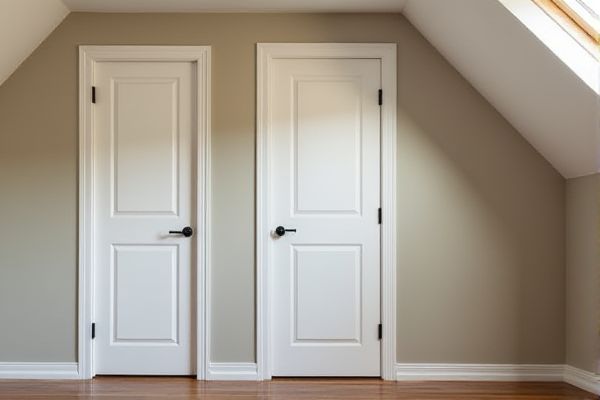
An insulated attic door provides superior thermal protection, reducing heat loss and improving energy efficiency compared to a standard attic door, which typically lacks sufficient insulation. Enhancing Your attic's insulation can lower utility bills and increase comfort, so explore the rest of the article to discover which option best suits Your home.
Table of Comparison
| Feature | Insulated Attic Door | Standard Attic Door |
|---|---|---|
| Thermal Insulation | High R-value insulation reduces heat loss | No or minimal insulation, allows heat transfer |
| Energy Efficiency | Improves home energy efficiency and reduces HVAC costs | Lower energy efficiency, more heat escape |
| Air Leakage | Sealed to prevent drafts and air infiltration | Potential air gaps, increases drafts |
| Material | Often features foam core or insulated panel construction | Simple wood or plywood construction without insulation |
| Cost | Higher upfront cost, long-term energy savings | Lower initial cost, higher energy expense over time |
| Installation | May require professional installation for sealing | Easy DIY installation |
| Durability | Better resistance to temperature changes and moisture | Less durable, prone to warping or damage |
Introduction to Attic Door Options
Insulated attic doors provide enhanced energy efficiency by reducing heat loss and improving thermal regulation compared to standard attic doors, which typically lack insulation. These insulated options often feature rigid foam cores or weatherstripping seals to minimize air leakage, boosting home comfort and lowering utility bills. Standard attic doors, while more affordable and easier to install, do not offer the same level of protection against temperature fluctuations or moisture infiltration in the attic space.
What Is a Standard Attic Door?
A standard attic door typically consists of a single-pane wood or metal panel without insulation, designed primarily for basic access rather than energy efficiency. It often lacks weatherstripping or an airtight seal, which can lead to heat loss and increased energy bills. Compared to insulated attic doors, standard versions offer minimal thermal protection and contribute less to maintaining consistent indoor temperatures.
What Is an Insulated Attic Door?
An insulated attic door is designed with built-in thermal barriers to reduce heat transfer between your living space and the attic, significantly improving energy efficiency. Unlike standard attic doors, which lack insulation, these doors help maintain consistent indoor temperatures and lower utility costs. Choosing an insulated attic door enhances your home's comfort by minimizing drafts and heat loss through the attic entry point.
Energy Efficiency Comparison
Insulated attic doors significantly improve energy efficiency by reducing heat loss and preventing drafts, leading to lower heating and cooling costs compared to standard attic doors. The insulation material in these doors typically has a higher R-value, providing better thermal resistance and maintaining consistent indoor temperatures. Upgrading to an insulated attic door enhances your home's overall energy performance and contributes to a more comfortable living environment.
Temperature Regulation Benefits
An insulated attic door offers superior temperature regulation by reducing heat transfer between your living space and the attic, resulting in a more consistent indoor climate. Unlike standard attic doors, insulated models help prevent heat loss during winter and minimize heat gain in summer, enhancing energy efficiency. This improves comfort throughout your home while lowering heating and cooling costs.
Impact on Home Comfort
Insulated attic doors significantly improve home comfort by reducing heat loss and preventing drafts, maintaining a consistent indoor temperature throughout the year. Standard attic doors often lack adequate insulation, leading to temperature fluctuations and increased energy consumption. Enhanced thermal performance of insulated attic doors contributes to lower heating and cooling costs while creating a more comfortable living environment.
Cost Differences and ROI
Insulated attic doors typically cost between $150 and $400, whereas standard attic doors range from $50 to $150, reflecting a higher initial investment for enhanced energy efficiency. Over time, the insulated door can offer a return on investment by reducing heating and cooling costs by up to 15%, depending on home insulation quality and climate. Homeowners may recoup the added expense within 3 to 5 years due to energy savings and improved comfort.
Soundproofing and Noise Control
Insulated attic doors provide superior soundproofing and noise control compared to standard attic doors due to their enhanced materials and construction that reduce sound transmission. These doors often feature foam insulation and airtight seals, effectively minimizing airborne noise from HVAC systems or external sources. Standard attic doors lack these features, resulting in higher noise infiltration and less effective sound dampening.
Installation Process and Compatibility
Insulated attic doors typically require additional sealing and proper fitting during installation to ensure thermal efficiency and prevent air leakage, which may involve insulation panels or weatherstripping not necessary for standard attic doors. Compatibility of insulated doors often demands careful measurement and adjustment to existing attic frames to maintain energy performance, while standard attic doors are generally easier to install with fewer modifications. Homeowners should consider the attic entry's structural dimensions and ventilation needs to choose the appropriate door type and installation method.
Which Attic Door Is Right for Your Home?
Insulated attic doors provide superior energy efficiency by reducing heat loss and preventing drafts compared to standard attic doors, making them ideal for homes seeking to lower utility bills and improve comfort. Standard attic doors are typically less expensive and easier to install but lack the thermal barrier that insulated versions offer, which can lead to higher energy costs in extreme climates. Choosing the right attic door depends on your home's insulation needs, budget, and long-term energy savings goals.
 homyna.com
homyna.com